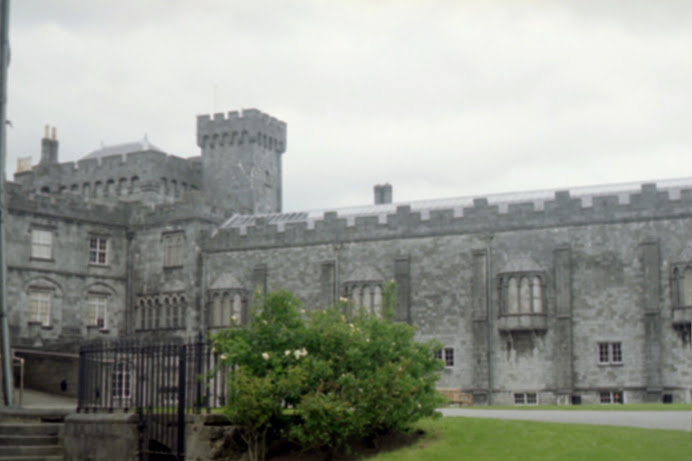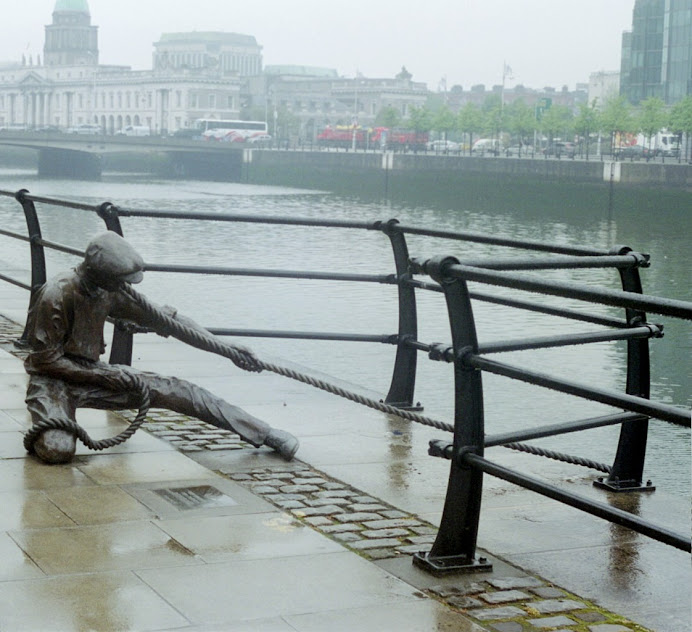Coming through the fresh, cool air of the Alps up the steep incline of the Löwenstrasse, or Lion Street, I caught my fist glimpse of the lion monument framed in the golden yellow of the eight AM sunlight and the green of a knoll that stood between us. Even from that distance the intricate details of each strand in his mane were obvious. But gazing upon hm from beyond the knoll with the brightness of a spring day in May made him appear deceptively cheerful.
Lucerne, Switzerland, located on the banks of Lake Lucerne in the center of the country, is home to the Löwendenkmal, lion monument. This stone statue is dedicated to the more than 700 Swiss guards who died during the French Revolution.
~~
Up close the lion is sobering and cold, evoking many emotions from his guests, but not one of them cheerful. He and the Swiss Alp he is carved into are a pale gray, almost white, cold and bleak as marble. The air too took a bitter turn as I reached the Löwenplatz, lion's place. What had been refreshing on the trek up the Alpine street, pricked like the tips of icicles as I stood in the shade of the Löwenplatz.
~~
Separated from the lion by an artificial pond, where I quietly watched several ducks swim, I spend what felt like hours studying the poignant form, especially the pitiable face of the dying lion.
~~
The lion lies on his right side, his back legs folded to the front and his tail whipped around to dangle partially from the ledge of his cave like den in the rock. His left front paw hangs down, carved so skillfully that you can see the muscles in his limb, the hairs that hang from the limb, the knuckles in the paw, even the claws protruding from more short hairs.
~~
His other paw rests on a bent shield, also carved from the rock, on which it is possible to make out a fleur de lit, the emblem of the French monarchy, which would have been displayed in gold on a white background. The Swiss guards he memorializes fell while protecting Louis XVI and his family in 1792. Their names are gravely inscribed in Latin on the sandstone below the lion.
~~
Next to the French shield a shield with the Swiss emblem of a cross is propped against the wall of the lion's cave. If it were not in the soft gray of the stone, the Swiss emblem would be red with a white cross. Several stone spears jut out in front of the lion crossing the shield. The tip of one spear is wedged into the lion's back.
~~
And on the paw that covers the French shield rests the lion's head. He dies slowly. His pained expression hear wrenching in its anguish. Mark Twain once called him the "saddest and most moving piece of rock in the world".
~~
Above the chin's delicately carved tuft of hair, his partially open mouth shows the tips of his canine teeth and tongue. The line of his top lip takes a sharp downward turn at his cheek.
The lines of his nose are sharply pulled in and following the slightly wrinkled bridge of the nose his eyes, crinkled and almost closed, convey the suffering of every soldier killed. Looking into those eyes, I could feel the smooth bumps of the cold stone in the deep creases of the forhead and the upper bridge of the nose.
~~
His mane stretches out from his slender face, flowing in a mass of wavy strands all carved from the white rock. I spent a good deal of time contemplating how painstaking and long a task it must have been for the artist to carve each hair, each separate strand so deeply and carefully that its intricacy could be seen from down the Löwenstrasse. The mane was so precisely carved that had the lion been painted in yellow and brown rather than the pale gray, I would have believed it possible to run my fingers through the straggling locks.
~~
I tore myself away from the lion to rejoin my group in a guided tour of Lucerne, but during our free time in the early afternoon I returned to the Löwenplatz. By then the sun had reached its zenith, and rather than casting soft sparkles of gold on the surrounding green and a soft white hue on the stone, the light was harsh.
~~
The light turned the dull tan and aqua tinted water of the pond to a wood color. It illuminated the stone terrace surounding the pond but cast the lion in deep, black shadow. The cave around him was suddenly dark, hiding the right side of his face and part of his back and mane. What remained protruding from the blackness was highlighted in yellow.
~~
The lion had lost his soft, sympathetic quality in the five hours since I'd first seen him. The bright lighting and harsh shadow now gave him a fierce quality, that of a wounded soldier not yet willing to give up the ghost. I could almost hear him roaring with pain and rage, half secluded in the safety of the his blackened den.
~~
Although I sat at a nearby bench and watched him for the better part of an hour that afternoon, studying once again the detail in his mane and forepaw, the image of him that I took home with me was one of cool, gray stone come alive, still suffering in the deep emotion of more than 200 years ago.
this posting also appears on http://traveltitbits.co.uk/features/löwendenkmal/



































































































































No comments:
Post a Comment